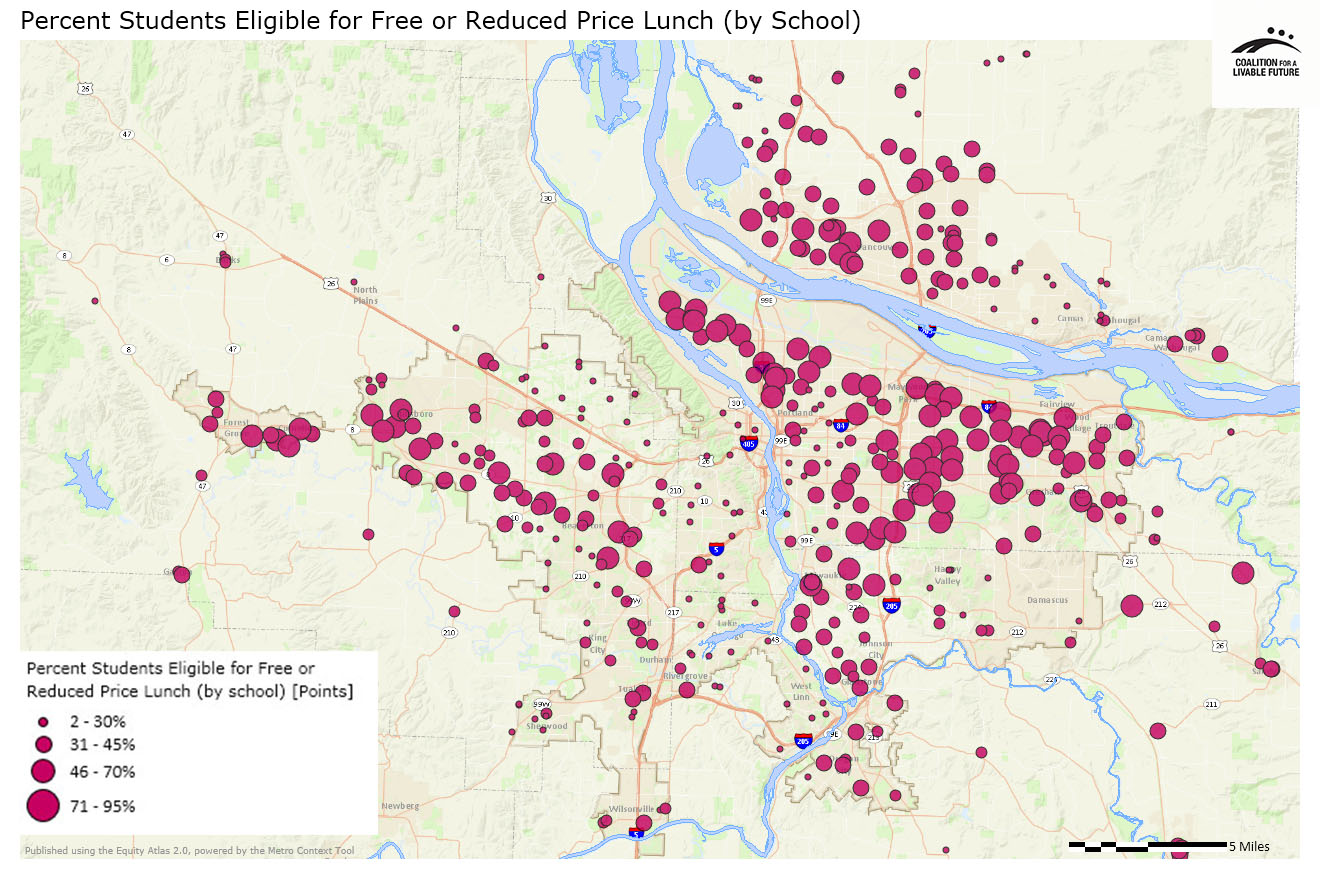Public Schools
A fundamental prerequisite for an equitable society is that all children have access to a quality education.
The Atlas includes a range of maps that depict the quality of educational offerings at the region’s schools. This map series begins our examination of quality education with some basic data about the region’s schools. The first map shows proximity to the nearest elementary school, which gives an indication of school walkability as well as geographic access to neighborhood schools. The second map shows the percentage of minority students by school. The third map shows the percentage of students at each school who are eligible for free or reduced price lunch, which serves as a proxy for poverty.



What the Maps Tell Us: Initial Findings
The Proximity to Nearest Elementary School map is useful for analyzing the walkability and basic geographic access to schools. (Note: The map measures the walking distance to the nearest elementary school, but the nearest elementary school may not necessarily be the assigned neighborhood school for each address.)
The Atlas mapping tool can be used to assign a proximity score to every neighborhood in the region based on the average proximity of every block in the neighborhood to an elementary school. A score of “5” indicates proximities within ¼ mile, while a score of “1” or below indicates proximities greater than 1 mile. The ten neighborhoods with the highest proximity scores to nearby elementary schools are located exclusively in the cities of Portland and Lake Oswego:
|
Neighborhood |
Location |
Proximity to Nearest Elementary School |
|---|---|---|
|
Portland |
5.00 |
|
|
Boise/Eliot |
Portland |
4.75 |
|
Multnomah County Unclaimed #6 (west of Hollywood District) |
Portland |
4.57 |
|
Grant Park |
Portland |
4.54 |
|
Sabin |
Portland |
4.43 |
|
Westridge |
Lake Oswego |
4.40 |
|
Multnomah County Unclaimed #5 (north of Grant Park) |
Portland |
4.33 |
|
Creston-Kenilworth |
Portland |
4.33 |
|
Clackamas County Unclaimed #4 (south of Glenmorrie) |
Lake Oswego |
4.33 |
|
Humboldt |
Portland |
4.31 |
The ten neighborhoods with the lowest proximity scores to nearby elementary schools tend to be characterized by primarily industrial, non-residential urban form and land use. Six of these neighborhoods are located in Vancouver, and the remaining four are commercial or industrial areas of Portland:
|
Neighborhood |
Location |
Proximity to Nearest Elementary School |
|---|---|---|
|
Multnomah County Unclaimed #2 (east of Bridgeton) |
Portland |
0.00 |
|
West Hazel Dell |
Vancouver |
0.47 |
|
Bridgeton |
Portland |
0.60 |
|
Riverview |
Vancouver |
0.62 |
|
Hayden Island |
Portland and unincorporated Multnomah County |
0.67 |
|
Columbia Way |
Vancouver |
0.67 |
|
East Old Evergreen Highway |
Vancouver and unincorporated Clark County |
0.71 |
|
Linnton |
Portland and unincorporated Multnomah County |
0.76 |
|
Fruit Valley |
Vancouver and unincorporated Clark County |
0.81 |
|
Esther Short |
Vancouver |
0.82 |
The Percent Minority Students (by School) map shows the relative percentage of students of color in each of the region’s public schools. Of the ten schools in the region with the highest percentages of minority students, seven are located in the city of Portland, primarily in north and northeast. The remaining three schools are located in the Washington County cities of Cornelius, Hillsboro and Beaverton:
|
School Name |
Level |
Location |
% Minority Students |
|---|---|---|---|
|
SEI Academy |
Middle |
Portland (Multnomah County) |
100.0 |
|
Humboldt Elementary |
Elementary |
Portland (Multnomah County) |
91.5 |
|
Cornelius Elementary |
Elementary |
Portland (Multnomah County) |
90.9 |
|
Rosa Parks |
Elementary |
Portland (Multnomah County) |
89.4 |
|
Woodlawn Elementary |
Elementary |
Portland (Multnomah County) |
86.8 |
|
Boise-Eliot Elementary |
Elementary |
Portland (Multnomah County) |
86.2 |
|
Cesar Chavez |
Elementary and Middle |
Portland (Multnomah County) |
86.1 |
|
Shaver Elementary |
Elementary |
Portland (Multnomah County) |
85.3 |
|
W.L. Henry Elementary |
Elementary |
Hillsboro (Washington County) |
84.0 |
|
Vose Elementary |
Elementary |
Beaverton (Washington County) |
82.3 |
The ten schools in the region with the lowest percentages of minority students are scattered throughout Clackamas and Clark counties, often in more rural areas. Two charter schools in the West Linn / Oregon City area are also on the list:
|
School Name |
Level |
% Minority Students |
Location |
|---|---|---|---|
|
Green Mountain School |
Elementary |
5.6 |
Woodland (Clark County) |
|
Hockinson High School |
High School |
5.6 |
Bush Prairie (Clark County) |
|
Yacolt Primary School |
Elementary |
6.2 |
Yacolt (Clark County) |
|
Colton Middle School |
Middle |
6.4 |
Colton (Clackamas County) |
|
Alliance Charter Academy |
Grades 1-12 |
6.5 |
Oregon City (Clackamas County) |
|
La Center Middle School |
Middle |
6.5 |
La Center (Clark County) |
|
Three Rivers Charter School |
Middle |
6.8 |
West Linn (Clackamas County) |
|
La Center High School |
High School |
7.2 |
La Center (Clark County) |
|
Amboy Middle School |
Middle |
7.3 |
Amboy (Clark County) |
|
Hockinson Heights Intermediate School |
Elementary |
7.5 |
Hockinson (Clark County) |
The Percent Students Eligible for Free or Reduced Price Lunch map shows the relative levels of poverty at the region's public schools, based on the percentage of students whose family incomes make them eligible for subsidized lunch. Of the ten schools in the region with the highest percentages of students eligible for free or reduced price lunch, most are located in Multnomah County in Gresham, north/northeast and outer east Portland. This includes two schools in north Portland, Rosa Parks Elementary and Humboldt Elementary, that are among the ten schools in the region with both the highest percent minority students and highest percent students eligible for free or reduced price lunch. The remaining schools on the list are located in Boring, Welches and Beaverton:
|
School Name |
Level |
% Students Eligible for Free or Reduced Price Lunch |
Location |
|---|---|---|---|
|
Alder Elementary |
Elementary |
94.3 |
Portland (Multnomah County) |
|
Hartley Elementary |
Elementary |
94.3 |
Gresham (Multnomah County) |
|
Rosa Parks |
Elementary |
94.2 |
Portland (Multnomah County) |
|
Davis Elementary |
Elementary |
94.2 |
Gresham (Multnomah County) |
|
Naas Elementary |
Elementary |
93.9 |
Boring (Clackamas County) |
|
Humboldt Elementary |
Elementary |
93.8 |
Portland (Multnomah County) |
|
Welches Middle |
Middle |
93.7 |
Welches (Clackamas County) |
|
Merlo Station |
High School |
93.2 |
Beaverton (Washington County) |
|
Centennial Learning Center |
Middle and High School |
92.6 |
Portland (Multnomah County) |
|
Glenfair Elementary |
Elementary |
92.5 |
Portland (Multnomah County) |
The ten schools with the lowest percentages of students eligible for free or reduced price lunch are located primarily in Portland’s west hills neighborhoods, Lake Oswego, and Sherwood.
|
School Name |
Level |
% Students Eligible for Free or Reduced Price Lunch |
Location |
|---|---|---|---|
|
Forest Park Elementary |
Elementary |
2.2 |
Portland (Multnomah County) |
|
Westridge Elementary |
Elementary |
3.8 |
Lake Oswego (Clackamas County) |
|
Findley Elementary |
Elementary |
4.5 |
Portland (Multnomah County) |
|
Ainsworth Elementary |
Elementary |
5.4 |
Portland (Multnomah County) |
|
Middleton Elementary |
Elementary |
5.8 |
Sherwood (Washington County) |
|
Lake Grove Elementary |
Elementary |
7.1 |
Lake Oswego (Clackamas County) |
|
Jacob Wismer Elementary |
Middle or Junior High |
7.3 |
Portland (Multnomah County) |
|
Lake Oswego High School |
High School |
8.2 |
Lake Oswego (Clackamas County) |
|
Forest Hills Elementary |
Elementary |
8.6 |
Lake Oswego (Clackamas County) |
|
Stephenson Elementary |
Elementary |
9.0 |
Portland (Multnomah County) |
About the Maps
Proximity to Nearest Elementary School
This map shows the walking distance to the nearest elementary school. The data include public schools and schools with special status (charter and alternative schools), but generally do not include private schools.
Though we have mapped the walking distance to the nearest elementary school, the nearest elementary school may not necessarily be the assigned neighborhood school for each address. Furthermore, in some school districts, children may have the option of attending elementary schools outside their catchment areas, meaning that their geographic access to education expands beyond their assigned neighborhood school.
Data Source: Metro RLIS 2012
Percent Minority Students (by School)
This map depicts the percentage of students per school that are identified in State Department of Education records as Hispanic, African-American, Asian, Native American, Other, and more than one race. These data have been provided by all public schools and schools with special status (charter and alternative schools), but generally do not include private schools.
Data Source: Oregon Department of Education and Washington Office of the Superintendent of Public Instruction, 2011-2012
Percent Students Eligible for Free or Reduced Price Lunch (by School)
This map shows the percentage of K-12 students identified as eligible for the free and reduced price lunch program, by school, for the 2011-2012 academic year. This indicator is often used as a proxy for childhood poverty.
Data Source: Oregon Department of Education and Washington Office of the Superintendent of Public Instruction, 2011-2012
*Some neighborhood boundaries overlap. The Atlas refers to the areas within the overlapping boundaries by the names of both neighborhoods.
|
This document was downloaded from the Map Series library of the Coalition for a Livable Future’s Regional Equity Atlas 2.0 website. The Regional Equity Atlas is a research and education project to promote widespread opportunity for a stronger, healthier, and more sustainable Portland-Vancouver metropolitan region. For more information, visit www.equityatlas.org. |
